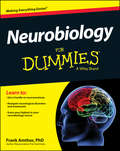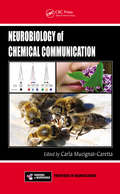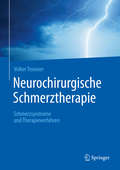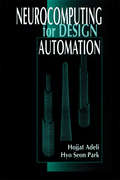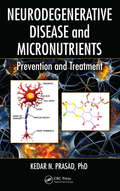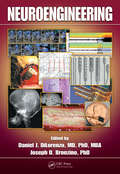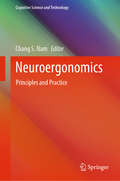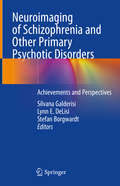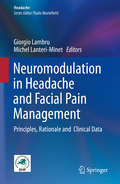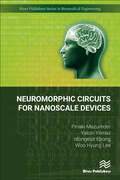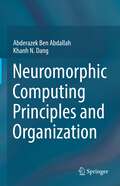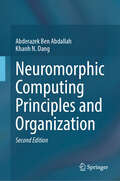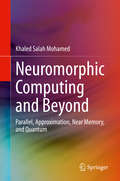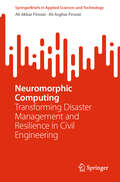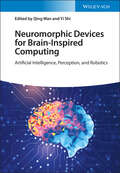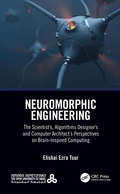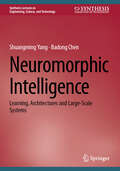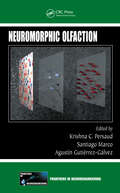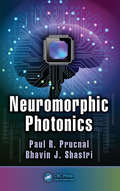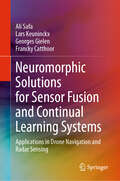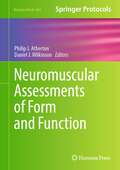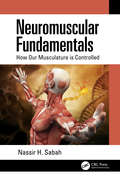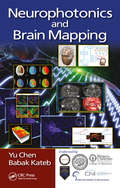- Table View
- List View
Neurobiology For Dummies
by Frank AmthorThe approachable, comprehensive guide to neurobiology Neurobiology rolls the anatomy, physiology, and pathology of the nervous system into one complex area of study. Neurobiology For Dummies breaks down the specifics of the topic in a fun, easy-to-understand manner. The book is perfect for students in a variety of scientific fields ranging from neuroscience and biology to pharmacology, health science, and more. With a complete overview of the molecular and cellular mechanisms of the nervous system, this complete resource makes short work of the ins and outs of neurobiology so you can understand the details quickly. Dive into this fascinating guide to an even more fascinating subject, which takes a step-by-step approach that naturally builds an understanding of how the nervous system ties into the very essence of human beings, and what that means for those working and studying in the field of neuroscience. The book includes a complete introduction to the subject of neurobiology. Gives you an overview of the human nervous system, along with a discussion of how it's similar to that of other animals Discusses various neurological disorders, such as strokes, Alzheimer's disease, Parkinson's disease, and schizophrenia Leads you through a point-by-point approach to describe the science of perception, including how we think, learn, and remember Neurobiology For Dummies is your key to mastering this complex topic, and will propel you to a greater understanding that can form the basis of your academic and career success.
Neurobiology of Chemical Communication (Frontiers in Neuroscience)
by Carla Mucignat-CarettaIntraspecific communication involves the activation of chemoreceptors and subsequent activation of different central areas that coordinate the responses of the entire organism-ranging from behavioral modification to modulation of hormones release. Animals emit intraspecific chemical signals, often referred to as pheromones, to advertise their prese
Neurochirurgische Schmerztherapie: Schmerzsyndrome Und Therapieverfahren
by Volker TronnierDie operativen und interventionellen Verfahren der Schmerztherapie sowie die Therapie der wichtigsten Schmerzsyndrome sind systematisch und detailliert in diesem Buch dargestellt. Technik und Ausführung der einzelnen Methoden werden ausführlich beschrieben, dabei sind sowohl neuroläsionelle und neuromodulierende Verfahren als auch die neurochirurgischen Therapieoptionen bei Gesichts- und Kopfschmerzen berücksichtigt. Zahlreiche Hinweise auf Tipps und Tricks erleichtern die Durchführung und erhöhen die Sicherheit der Anwendung. Aus den publizierten Behandlungsergebnissen wird der Stellenwert der Verfahren für die möglichen Indikationen abgeleitet. Therapieempfehlungen für die einzelnen Schmerzsyndrome beziehen alle Behandlungsmodalitäten ein und ermöglichen so ein indikationsspezifisches, patientenorientiertes Vorgehen.
Neurocomputing for Design Automation (Computer Aided Engineering)
by Hyo Seon ParkNeurocomputing for Design Automation provides innovative design theories and computational models with two broad objectives: automation and optimization.This singular book:Presents an introduction to the automation and optimization of engineering design of complex engineering systems using neural network computing Outlines new computational models and paradigms for automating the complex process of design for unique engineering systems, such as steel highrise building structures Applies design theories and models to the solution of structural design problems Integrates three computing paradigms: mathematical optimization, neural network computing, and parallel processingThe applications described are general enough to be applied directly or by extension to other engineering design problems, such as aerospace or mechanical design. Also, the computational models are shown to be stable and robust - particularly suitable for design automation of large systems, such as a 144-story steel super-highrise building structure with more than 20,000 members.The book provides an exceptional framework for the automation and optimization of engineering design, focusing on a new computing paradigm - neural networks computing. It presents the automation of complex systems at a new and higher level never achieved before.
Neurodegeneration and Alzheimer's Disease: The Role of Diabetes, Genetics, Hormones, and Lifestyle
by Ralph N. Martins Charles S. Brennan Binosha Fernando Margaret A. Brennan Stephanie J. FullerUnderstanding the impact of diet, exercise, genetics, and hormones on the risk and development of Alzheimer’s and other neurogenerative diseases Diet is widely known to impact on neurological function. Nevertheless, academic texts discussing this relationship are relatively few in number. This book therefore fills an important gap in the current literature. Opening with an overview of neurodegenerative diseases, particularly Alzheimer’s disease, the text then focuses on explaining the means by which glycemic control and lipid metabolism – and associated nutritional and lifestyle variables – may factor into such disorders’ prevention and treatment. An international group of experts in the fields of food science and neurodegeneration have contributed chapters that examine Alzheimer’s disease within a broad range of contexts. Offering dietary, genetic, and hormonal perspectives, the authors explore topics ranging from sugar consumption to digestive fermentation, and Alzheimer’s disease animal models to the cognition-enhancing effects of physical exercise. Also included are overviews of the latest research into current and developing methods of treatment and diagnosis, as well as differential diagnostics. This groundbreaking book: Explores how glucose metabolism, insulin resistance, lipid metabolism, and high intake of refined carbohydrates are linked to Alzheimer's disease Discusses how genetic makeup can impact risk of Alzheimer’s and Parkinson’s disease Examines cognitive changes in neurodegeneration, lists current tests for determining cognitive impairment, and provides information concerning differential diagnosis Discusses potential advantages of increasing antioxidant and micronutrient intake Reviews hormonal influences on neurodegeneration Examines the links between protein intake and Alzheimer’s disease. Neurodegeneration and Alzheimer's Disease is an essential resource for researchers, medical practitioners, dietitians, and students with an interest in neurological diseases and their diagnosis and risk factors, as well as diet-related conditions such as diabetes and obesity. Lifestyle and diet influence neurodegeneration risk, and a better understanding of this evidence amongst health professionals will hopefully lead to greater public awareness of how to reduce the likelihood of these widespread conditions.
Neurodegenerative Disease and Micronutrients: Prevention and Treatment
by Kedar N. PrasadThe book proposes that a preparation of antioxidants and micronutrients, in combination with standard therapy, may reduce progression and improve management better than standard therapy alone for Alzheimer's, Parkinson's, and Huntington's disease, as well as PTSD, traumatic brain injury, concussions, and cerebral vascular insufficiency. The book pr
Neuroengineering
by Joseph D. Bronzino Daniel J. DiLorenzoBased on a foundation of science and empirical observation, engineering research and design has brought science fiction into science fact. The convergence of neuroscience and technology is facilitating the development of therapies that not long ago would have seemed unimaginable, if not impossible. With contributions from pioneers in industry, acad
Neuroergonomics: Principles and Practice (Cognitive Science and Technology)
by Chang S. NamThis book sums up key research findings, and theoretical and technological advances having a direct bearing on neuroergonomics. Neuroergonomics is an emerging area whose Neuroergonomics is an emerging area that is collectively defined as the study of human brain function and behaviour in relation to behavioural performance in natural environments and everyday settings. It helps readers to understand neural mechanisms of human cognition in the context of human interaction with complex systems, as well as understanding the change of perception, decision-making and training in humans. The authors give new insights into augmenting human performance, reflecting upon the opportunities provided through neuroergonomics research and development. Computer systems acting on data from behavioural-output, physiological, and neurological sensing technologies are used to determine the user’s cognitive state and adapt the systems to change, support, and monitor human cognition. Various domains and case studies delve into the field of neuroergonomics in detail. These include, but are not limited to:an evaluation of technologies in health, workplace, and education settings, to show the different impacts of neuroergonomics in everyday lives;assessment of real-time cognitive measures;dynamic casual interactions between inhibition and updating functions, through analysis of behavioral, neurophysiological and effective connectivity metrics; and applications in human performance modelling and assessment of mental workload, showing the reader how to train and improve working memory capacity.Neuroergonomics: Principles and Practice provides academic practitioners and graduate students with a single go-to handbook that will be of significant assistance in research associated with human factors and ergonomics, human-computer interaction, human-systems engineering and cognitive neuroscience.
Neuroimaging of Schizophrenia and Other Primary Psychotic Disorders: Achievements And Perspectives
by Silvana Galderisi Lynn E. DeLisi Stefan BorgwardtThis book presents the state of the art in the use of neuroimaging technologies in the study of schizophrenia and other primary psychotic disorders. The contributions of neuroimaging in the characterization of these disorders are reviewed across diagnoses, by focusing on psychopathological domains and at-risk populations in order to understand the implications for treatment. The principal neuroimaging findings are described in detail, identifying those that are common to and specific for each disorder and highlighting important pitfalls. Attention is drawn to potential translational aspects of research in the field, with discussion of emerging innovative perspectives. Neuroimaging research has shown that abnormalities of brain structure and function associated with psychiatric disorders do not reflect the boundaries of current diagnostic categories. However, neuroimaging findings are being reconsidered in the light of recent research proposals aimed at re-conceptualizing classification systems in Psychiatry. Written by leading experts, this book will appeal to all with an interest in the field, including researchers, clinicians, and trainees.
Neuromodulation in Headache and Facial Pain Management: Principles, Rationale and Clinical Data (Headache)
by Giorgio Lambru Michel Lanteri-MinetThis book addresses all aspects of neuromodulation therapy in the management of headache and facial pain disorders, paying particular attention to the application of this rapidly growing and fascinating therapy to different forms of headache and facial pain conditions. It is divided into sections covering the principles of and rationale behind neuromodulation for headache, including in-depth discussions of challenging topics such as the definition of refractory headache and prognostic factors, and the technical aspects of devices used to modulate peripheral and central neuronal targets for the management of headaches. In addition, the book reviews the state-of-the art in current neuromodulation practice for headaches, discusses therapeutic strategies and therapy selection for each headache and facial pain disorder, and presents an in-depth, critical analysis of the published evidence, with sections covering innovative devices and emerging applications of novel neuromodulation technologies in the field. Gathering papers by internationally respected, leading experts, the book offers a unique guide to neuromodulation therapies in headache for neurologists, pain specialists, neurosurgeons, neuroscientists, trainees and general practitioners with an interest in headache and facial pain management.
Neuromorphic Circuits for Nanoscale Devices
by Pinaki Mazumder Yalcin Yilmaz Idongesit EbongNanoscale devices attracted significant research effort from the industry and academia due to their operation principals being based on different physical properties which provide advantages in the design of certain classes of circuits over conventional CMOS transistors. Neuromorphic Circuits for Nanoscale Devices contains recent research papers presented in various international conferences and journals to provide insight into how the operational principles of the nanoscale devices can be utilized for the design of neuromorphic circuits for various applications of non-volatile memory, neural network training/learning, and image processing. The topics discussed in the book include:Nanoscale Crossbar Memory DesignQ-Learning and Value Iteration using Nanoscale DevicesImage Processing and Computer Vision Applications for Nanoscale DevicesNanoscale Devices based Cellular Nonlinear/Neural Networks
Neuromorphic Computing Principles and Organization
by Abderazek Ben Abdallah Khanh N. DangThis book focuses on neuromorphic computing principles and organization and how to build fault-tolerant scalable hardware for large and medium scale spiking neural networks with learning capabilities. In addition, the book describes in a comprehensive way the organization and how to design a spike-based neuromorphic system to perform network of spiking neurons communication, computing, and adaptive learning for emerging AI applications. The book begins with an overview of neuromorphic computing systems and explores the fundamental concepts of artificial neural networks. Next, we discuss artificial neurons and how they have evolved in their representation of biological neuronal dynamics. Afterward, we discuss implementing these neural networks in neuron models, storage technologies, inter-neuron communication networks, learning, and various design approaches. Then, comes the fundamental design principle to build an efficient neuromorphic system in hardware. The challenges that need to be solved toward building a spiking neural network architecture with many synapses are discussed. Learning in neuromorphic computing systems and the major emerging memory technologies that promise neuromorphic computing are then given.A particular chapter of this book is dedicated to the circuits and architectures used for communication in neuromorphic systems. In particular, the Network-on-Chip fabric is introduced for receiving and transmitting spikes following the Address Event Representation (AER) protocol and the memory accessing method. In addition, the interconnect design principle is covered to help understand the overall concept of on-chip and off-chip communication. Advanced on-chip interconnect technologies, including si-photonic three-dimensional interconnects and fault-tolerant routing algorithms, are also given. The book also covers the main threats of reliability and discusses several recovery methods for multicore neuromorphic systems. This is important for reliable processing in several embedded neuromorphic applications. A reconfigurable design approach that supports multiple target applications via dynamic reconfigurability, network topology independence, and network expandability is also described in the subsequent chapters. The book ends with a case study about a real hardware-software design of a reliable three-dimensional digital neuromorphic processor geared explicitly toward the 3D-ICs biological brain’s three-dimensional structure. The platform enables high integration density and slight spike delay of spiking networks and features a scalable design. We present methods for fault detection and recovery in a neuromorphic system as well.Neuromorphic Computing Principles and Organization is an excellent resource for researchers, scientists, graduate students, and hardware-software engineers dealing with the ever-increasing demands on fault-tolerance, scalability, and low power consumption. It is also an excellent resource for teaching advanced undergraduate and graduate students about the fundamentals concepts, organization, and actual hardware-software design of reliable neuromorphic systems with learning and fault-tolerance capabilities.
Neuromorphic Computing Principles and Organization
by Abderazek Ben Abdallah Khanh N. DangThe second edition of Neuromorphic Computing Principles and Organization delves deeply into neuromorphic computing, focusing on designing fault-tolerant, scalable hardware for spiking neural networks. Each chapter includes exercises to enhance understanding. All existing chapters have been meticulously revised, and a new chapter on advanced neuromorphic prosthesis design serves as a comprehensive case study. The book starts with an overview of neuromorphic systems and fundamental artificial neural network concepts. It explores artificial neurons, neuron models, storage technologies, inter-neuron communication, learning mechanisms, and design approaches. Detailed discussions cover challenges in constructing spiking neural networks and emerging memory technologies. A dedicated chapter addresses circuits and architectures, including Network-on-Chip (NoC) fabric, Address Event Representation (AER), memory access methods, and photonic interconnects. Reliability issues, recovery methods for multicore systems, and reconfigurable designs supporting multiple applications are examined. The book also describes the hardware-software design of a three-dimensional neuromorphic processor, focusing on high integration density, minimal spike delay, and scalable design. The book concludes with a comprehensive review of neuromorphic systems, providing a detailed analysis of the field and an overarching understanding of the key concepts discussed throughout the text.
Neuromorphic Computing and Beyond: Parallel, Approximation, Near Memory, and Quantum
by Khaled Salah MohamedThis book discusses and compares several new trends that can be used to overcome Moore’s law limitations, including Neuromorphic, Approximate, Parallel, In Memory, and Quantum Computing. The author shows how these paradigms are used to enhance computing capability as developers face the practical and physical limitations of scaling, while the demand for computing power keeps increasing. The discussion includes a state-of-the-art overview and the essential details of each of these paradigms.
Neuromorphic Computing: Transforming Disaster Management and Resilience in Civil Engineering (SpringerBriefs in Applied Sciences and Technology)
by Ali Akbar Firoozi Ali Asghar FirooziThis book delves into the transformative potential of neuromorphic computing within the field of civil engineering, specifically focusing on its application to disaster management. With the increasing frequency and severity of natural disasters, traditional disaster management systems face significant challenges in prediction accuracy, response time, and effective resource allocation. Neuromorphic computing, inspired by the neural processes of the human brain, offers a revolutionary approach to addressing these challenges. Through an in-depth exploration, this book outlines the theoretical foundations of neuromorphic computing, its integration into smart infrastructure, and the development of advanced predictive models for natural disasters such as earthquakes, floods, and urban fires. Additionally, it examines the technical, ethical, and social considerations inherent in deploying these technologies, alongside a vision for their future development. The convergence of neuromorphic computing and civil engineering heralds a new era of enhanced resilience, where more informed, rapid, and effective disaster management strategies are not just a possibility but a reality. The book contributes to the discourse on leveraging cutting-edge computing technologies to foster safer, more resilient communities in the face of natural calamities.
Neuromorphic Devices for Brain-inspired Computing: Artificial Intelligence, Perception, and Robotics
by Yi Shi Qing WanExplore the cutting-edge of neuromorphic technologies with applications in Artificial Intelligence In Neuromorphic Devices for Brain-Inspired Computing: Artificial Intelligence, Perception, and Robotics, a team of expert engineers delivers a comprehensive discussion of all aspects of neuromorphic electronics designed to assist researchers and professionals to understand and apply all manner of brain-inspired computing and perception technologies. The book covers both memristic and neuromorphic devices, including spintronic, multi-terminal, and neuromorphic perceptual applications. Summarizing recent progress made in five distinct configurations of brain-inspired computing, the authors explore this promising technology’s potential applications in two specific areas: neuromorphic computing systems and neuromorphic perceptual systems. The book also includes: A thorough introduction to two-terminal neuromorphic memristors, including memristive devices and resistive switching mechanisms Comprehensive explorations of spintronic neuromorphic devices and multi-terminal neuromorphic devices with cognitive behaviors Practical discussions of neuromorphic devices based on chalcogenide and organic materials In-depth examinations of neuromorphic computing and perceptual systems with emerging devices Perfect for materials scientists, biochemists, and electronics engineers, Neuromorphic Devices for Brain-Inspired Computing: Artificial Intelligence, Perception, and Robotics will also earn a place in the libraries of neurochemists, neurobiologists, and neurophysiologists.
Neuromorphic Engineering: The Scientist’s, Algorithms Designer’s and Computer Architect’s Perspectives on Brain-Inspired Computing
by Elishai Ezra TsurThe brain is not a glorified digital computer. It does not store information in registers, and it does not mathematically transform mental representations to establish perception or behavior. The brain cannot be downloaded to a computer to provide immortality, nor can it destroy the world by having its emerged consciousness traveling in cyberspace. However, studying the brain's core computation architecture can inspire scientists, computer architects, and algorithm designers to think fundamentally differently about their craft. Neuromorphic engineers have the ultimate goal of realizing machines with some aspects of cognitive intelligence. They aspire to design computing architectures that could surpass existing digital von Neumann-based computing architectures' performance. In that sense, brain research bears the promise of a new computing paradigm. As part of a complete cognitive hardware and software ecosystem, neuromorphic engineering opens new frontiers for neuro-robotics, artificial intelligence, and supercomputing applications. This book will present neuromorphic engineering from three perspectives: the scientist, the computer architect, and the algorithm designer. We will zoom in and out of the different disciplines, allowing readers with diverse backgrounds to understand and appreciate the field. Overall, the book will cover the basics of neuronal modeling, neuromorphic circuits, neural architectures, event-based communication, and the neural engineering framework. Readers will have the opportunity to understand the different views over the inherently multidisciplinary field of neuromorphic engineering.
Neuromorphic Intelligence: Learning, Architectures and Large-Scale Systems (Synthesis Lectures on Engineering, Science, and Technology)
by Badong Chen Shuangming YangThis book provides a valuable resource on the design of neuromorphic intelligence, which serves as a computational foundation for building compact and low-power brain-inspired intelligent systems. The book introduces novel spiking neural network learning algorithms, including spike-based learning based on the multi-compartment model and spike-based learning with information theory. These offer important insights and academic value for readers to grasp the latest advances in neural-inspired learning. Additionally, the book presents insights and approaches to the design of scalable neuromorphic architectures, which are crucial foundations for achieving highly cognitive and energy-efficient computing systems. Furthermore, the book introduces representative large-scale neuromorphic systems and reviews several recently implemented large-scale digital neuromorphic systems by the authors, providing corresponding application scenarios.
Neuromorphic Olfaction
by Santiago Marco Krishna C. Persaud Agustín Gutiérrez-GálvezMany advances have been made in the last decade in the understanding of the computational principles underlying olfactory system functioning. Neuromorphic Olfaction is a collaboration among European researchers who, through NEUROCHEM (Fp7-Grant Agreement Number 216916)-a challenging and innovative European-funded project-introduce novel computing p
Neuromorphic Photonics
by Paul R. Prucnal Bhavin J. ShastriThis book sets out to build bridges between the domains of photonic device physics and neural networks, providing a comprehensive overview of the emerging field of "neuromorphic photonics." It includes a thorough discussion of evolution of neuromorphic photonics from the advent of fiber-optic neurons to today’s state-of-the-art integrated laser neurons, which are a current focus of international research. Neuromorphic Photonics explores candidate interconnection architectures and devices for integrated neuromorphic networks, along with key functionality such as learning. It is written at a level accessible to graduate students, while also intending to serve as a comprehensive reference for experts in the field.
Neuromorphic Solutions for Sensor Fusion and Continual Learning Systems: Applications in Drone Navigation and Radar Sensing
by Francky Catthoor Georges Gielen Ali Safa Lars KeuninckxThis book provides novel theoretical foundations and experimental demonstrations of Spiking Neural Networks (SNNs) in tasks such as radar gesture recognition for IoT devices and autonomous drone navigation using a fusion of retina-inspired event-based camera and radar sensing. The authors describe important new findings about the Spike-Timing-Dependent Plasticity (STDP) learning rule, which is widely believed to be one of the key learning mechanisms taking place in the brain. Readers will be enabled to create novel classes of edge AI and robotics applications, using highly energy- and area-efficient SNNs
Neuromorphic and Brain-Based Robots
by Hiroaki Wagatsuma Jeffrey L. KrichmarNeuromorphic and brain-based robotics have enormous potential for furthering our understanding of the brain. By embodying models of the brain on robotic platforms, researchers can investigate the roots of biological intelligence and work towards the development of truly intelligent machines. This book provides a broad introduction to this groundbreaking area for researchers from a wide range of fields, from engineering to neuroscience. Case studies explore how robots are being used in current research, including a whisker system that allows a robot to sense its environment and neurally inspired navigation systems that show impressive mapping results. Looking to the future, several chapters consider the development of cognitive, or even conscious robots that display the adaptability and intelligence of biological organisms. Finally, the ethical implications of intelligent robots are explored, from morality and Asimov's three laws to the question of whether robots have rights.
Neuromuscular Assessments of Form and Function (Neuromethods #204)
by Philip J. Atherton Daniel J. WilkinsonThis volume looks at the latest methods used to study imaging techniques, metabolic tracing, and deep muscle phenotyping. The chapters in this book cover topics such as imaging skeletal muscle mass using MRI, dual-energy x-ray absorptiometry, CT, and ultrasound; measures of neuromuscular function such as power/strength/force; microscopy and immunohistochemistry; and ex vivo fibre function and isolation. In the Neuromethods series style, chapters include the kind of detail and key advice from the specialists needed to get successful results in your laboratory. Comprehensive and thorough, Neuromuscular Assessments of Form and Function is a valuable resource for researchers interested in multiple methods used to study skeletal muscle neurophysiology.
Neuromuscular Fundamentals: How Our Musculature is Controlled
by Nassir H. SabahThis book is rather unique in its approach and coverage. The approach is essentially that of an engineering textbook, emphasizing the quantitative aspects and highlighting the fundamentals and basic concepts involved. The coverage progresses in a logical and systematic manner from the subcellular, starting with the electrophysiology of the cell membrane, then proceeding to synapses, neurons, and muscle, before considering neuronal motor ensembles and the neuromuscular system as a whole. Simple, clear, and comprehensive explanations are given throughout. After an introductory chapter on some background material in biology, biophysics, and chemical kinetics, a substantial part of the book (Chapters 2-8) necessarily covers in considerable detail the basic components and processes that underlie the electrical and associated activities of the nervous system. The remaining chapters of the book (Chapters 9-13) focus on the neuromuscular system, starting with the structure of muscle cells, the generation of force by muscular contraction, and muscle receptors. The last chapter examines aspects of the control of movement, motor learning and memory, the maintenance of posture, and locomotion, and critically examines some of the theories that have been advanced to explain how movement is controlled. The book is intended for undergraduate or graduate students in the natural sciences, mathematics, or engineering who seek a deeper understanding of the fundamentals of neuroscience and the somatomotor system, in accordance with the aforementioned objectives. The book can serve as a textbook for a one-semester course on the neuromuscular system or as a reference in a more general course on neuroscience. Provides a thorough analytical treatment of membrane electrophysiology, starting from the first principles Emphasizes strongly the basic and fundamental concepts throughout Discusses thoroughly the essential features and properties of the basic constituents of the nervous system, that is, neurons and synapses, including the neuromuscular junction Explains the main aspects of posture, locomotion, and control of movement Includes practice problems throughout the text and a solutions manual will be available for adopting professors Nassir Sabah is professor of biomedical engineering in the electrical and computer engineering department at the American University of Beirut, Lebanon. He received his B.Sc. (Hons. Class I) and his M.Sc. in electrical engineering from the University of Birmingham, U.K., and his Ph.D. in biophysical sciences from the State University of New York (SUNY/Buffalo). He has served as Chairman of the Electrical Engineering Department, Director of the Institute of Computer Studies, and Dean of the Faculty of Engineering and Architecture at the American University of Beirut. In these capacities, he was responsible for the development of programs, curricula, and courses in electrical, biomedical, communications, and computer engineering. Professor Sabah has extensive professional experience in the fields of electrical engineering, electronics, and computer systems, with more than 35 years’ teaching experience in neuroengineering, biomedical engineering, electronics, and electric circuits. He has over 100 technical publications, mainly in neurophysiology, biophysics, and biomedical instrumentation. He has served on numerous committees and panels in Lebanon and the region. He is a Fellow of the Institution of Engineering and Technology (IET, U.K.), a member of the American Association for the Advancement of Science (AAAS), and a member of the American Society for Engineering Education (ASEE).
Neurophotonics and Brain Mapping
by Yu Chen Babak KatebUnderstanding how the brain works and developing effective therapeutics are important in advancing neuroscience and improving clinical patient care. Neurophotonics and Brain Mapping covers state-of-the-art research and development in optical technologies and applications for brain mapping and therapeutics. It provides a comprehensive overview of various methods developed using light, both microscopic and macroscopic techniques. Recent developments in minimally-invasive endoscopic imaging of deep brain structure and function, as well as light-based therapy are also reviewed.
